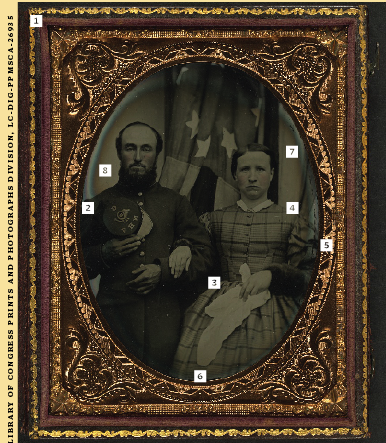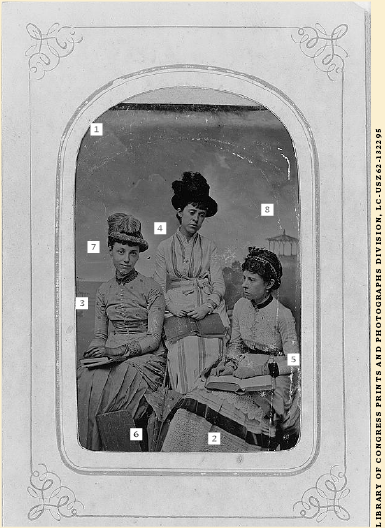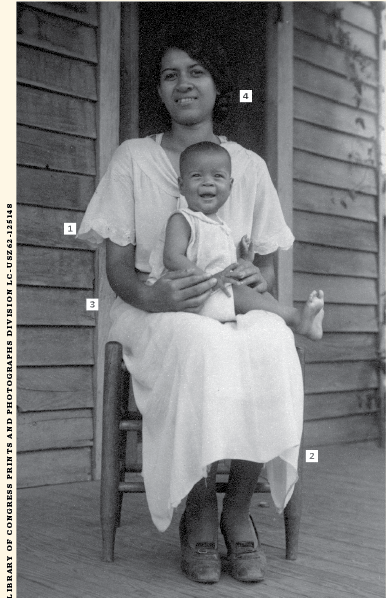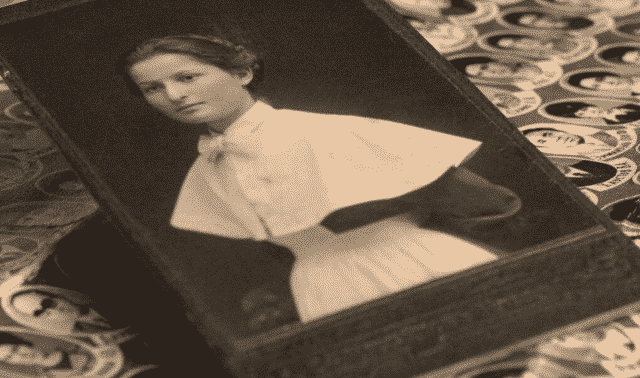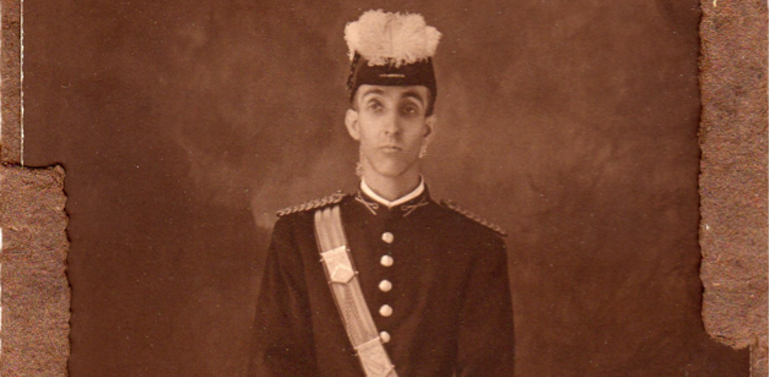Sign up for the Family Tree Newsletter! Plus, you’ll receive our 10 Essential Genealogy Research Forms PDF as a special thank you.
Get Your Free Genealogy Forms
"*" indicates required fields
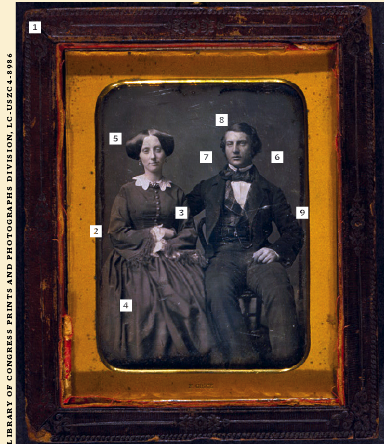
1. The daguerreotype format points to a time frame from 1839 to the mid-1860s.
2. Women’s sleeves of the 1850s were narrow at the shoulder and flared at the wrist, often revealing a white undersleeve.
3. Front-fastening dresses with broad collars like this one gained popularity during the 1850s.
4. Full skirts were gathered over hoops.
5. Hair parted at the center and styled to cover the ears is common for women during this decade.
6. Men’s shirt collars were turned over 2-inch-wide neckties worn in wide half-bows.
7. Like most men of the era, this man is clean-shaven.
8. Men usually oiled their hair and kept it long on top.
9. You’ll see narrow sleeves and fitted coats early in the decade; more generous cuts were common in the mid- to late-1850s.
Photography was becoming more accessible to average Americans during the late 19th century. Many families treasured photos of their soldiers posed in uniform before marching into the Civil War.
1. The daguerreotype was still a common type of photograph during the 1960s.
2. The cap insignia is from the 12th New Hampshire Infantry Regiment, Company G. Military insignia can help you identify a unit and lead to service or pension records.
3. Most Civil War-era dresses featured snug bodices that buttoned down the front over a corset.
4. A high, narrow collar was typical, but you’ll sometimes see dresses with v-necks and lapels.
5. Sleeve styles varied; this one has a full upper arm and fur trim.
6. Skirts of the 1860s were full and gathered, often supported by hoops or multiple petticoats.
7. Though elaborate hairstyles—sometimes employing faux hairpieces—were becoming popular, many women still wore their hair pulled back and close to the head.
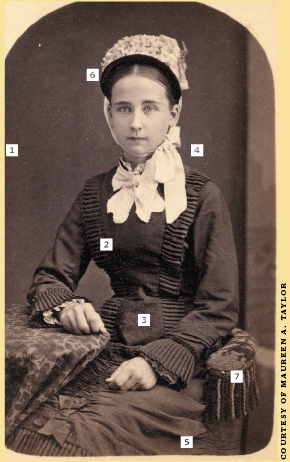
1. The card photo was popular during the 1870s and 1880s. Standard sizes included 2½x4 inches (the carte de visite), 4½x6½ inches and 3¼x5 inches.
2. Ruffles, such as those trimming this woman’s bodice, sleeves and skirt, became stylish in the 1870s.
3. Mid-decade, bodices lengthened to reach as low as the hips.
4. High necklines featured low-standing collars opened at
the front.
5. Skirts became narrower during this decade, though many featured fullness in the back with bustles.
6. Women continued to part their hair in the center. Small hats and bonnets were trimmed with feathers, lace and flowers.
7. Upholstered chairs with fringe began to appear in photographers’ studios during the late 1860s.
The daguerreotype had peaked in popularity; now Americans preferred tintypes and albumen prints. Women’s clothing became less restrictive as they began to work as secretaries, telephone operators and store clerks. Young women such as these ladies were switching from bonnets to more-fashionable hats.
1. Tintypes (actually printed on iron) were created from the 1850s to the late 1800s. A magnet will cling to the surface and rust spots may be visible. Marks on this image show it’s been removed from a frame.
2. Draped overskirts, often apronlike in shape, were common on dresses of this decade.
3. Tight bodices, buttoned at the front, extended below the waist.
4. High necklines like the ones these women wore had low-standing collars.
5. Sleeves were three-quarter length, snug and often ended in decorative trim at the wrist.
6. Ladies often posed for photographs with accessories such as parasols.
7. Women of the 1880s usually wore their hair frizzed around the face with a bun in back. Hats came in a variety of styles, often with high crowns and elaborate trim.
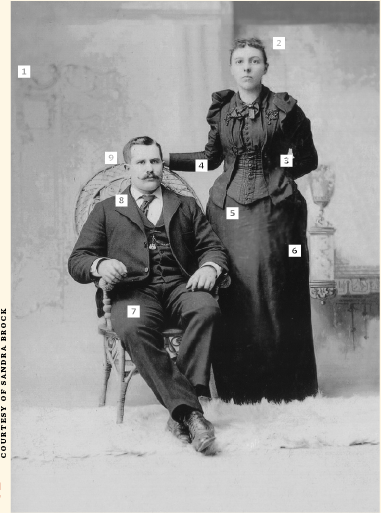
1. By the 1890s, paper prints were common.
2. Short, frizzed bangs like this woman’s remained popular during the early 1890s.
3. Women still wore corsets to create an hourglass silhouette.
4. Full sleeves, gathered at the shoulder and snug at the wrist, were common during this era (as the decade progressed,
“leg-o-mutton” sleeves exaggerated this style).
5. The waistcoat effect was popular in women’s dresses during the 1880s; this woman may be wearing an older dress to pose for this 1894 photo.
6. Skirts were narrow and smooth at the hips.
7. Men’s coats, trousers and ties were narrow.
8. Shirts of the 1890s featured small, stiff, pointed collars, which rose higher on the neck as the decade progressed.
9. Most men during this decade wore their hair short and grew large, shapely mustaches.
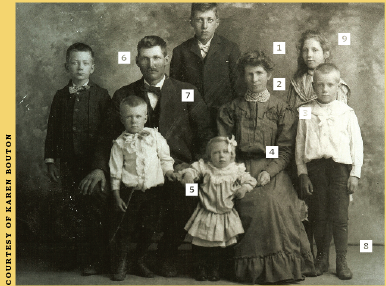
Children’s styles echoed those of adults, as you can see here, with modifications for the very young—handy for estimating ages. Toddlers of both sexes wore dresses to allow for activity and diapering access. To differentiate little boys and girls in photos, look at the hair: Girls’ hair was generally parted in the center; boys’, on the side.
1. Fuller women’s hairstyles were influenced by the Gibson Girl trend.
2. High collars to the chin were typical of the era.
3. Women’s sleeves featured fullness in the upper arm.
4. Bloused bodices gave women more ease of movement starting in the late 1890s. Skirts were softly gathered.
5. This little boy’s floppy lace collar and sashed dress was characteristic of the Little Lord Fauntleroy look, popular around the turn of the century.
6. Most men of the early 1900s wore short hair. Mustaches were neatly trimmed.
7. Men’s suits had simple sack coats. Waistcoats were generally single-breasted and fastened high on the chest.
8. Boys wore short pants until approximately age 12.
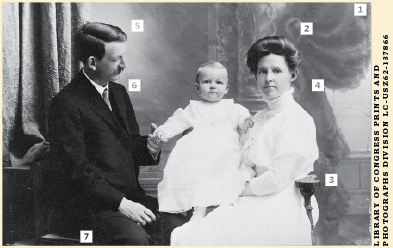
1. Black and white snapshots, sent away for developing and returned to the photographer mounted on cardstock, were now widely used.
2. Women wore their hair pulled back, but soft and wide around the face.
3. Shirtwaist-style bodices were bloused over wide waistbands.
4. Women’s high collars still reached the chin during this era.
5. This man’s slicked-back hair was a common look.
6. Neckties were relatively narrow.
The “Roaring 20s” ushered in radical changes for women’s fashion: Short hair, higher hemlines, dropped waists and looser styles prevailed. Corsets were discarded in favor of camisoles and bloomers. Many Americans were reluctant to adopt the new styles at first, but had largely embraced them by mid-decade. Men’s clothing changed, too: Straight, short pants widened; lapels also widened and sleeves were looser.
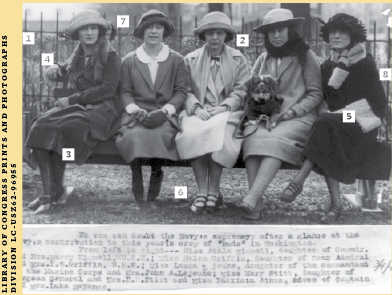
1. Candid snapshots had become common by the 1920s.
2. In a hairstyle revolution popularized by French dancer Irene Castle, women flocked to barbershops to get short bobs.
3. Hemlines rose throughout the decade, reaching just above the knee by about 1925.
4. Ermine and mink shawls were popular accessories.
5. Looser fitting, lower waistlines characterized the “flapper” era.
6. Shorter hemlines showed off high-heeled shoes in the fashionable Mary Jane style.
7. Cloche hats, worn low on the forehead, were popular.
8. New types of fasteners, such as zippers and hooks and eyes, had come into use by this decade.
The Great Depression brought a more conservative era, with longer hemlines and hair, and natural waistlines for women. Clothing in photos may show evidence of age: As the Great Depression wore on, many Americans made do with what they had, mending and altering old outfits.
1. This woman’s flutter sleeve is characteristic of 1930s attention at the shoulder.
2. Skirts lengthened as the 1930s progressed.
3. The waist of this woman’s dress, just visible here, sits at her natural waist.
4. Longer hair curled at the ends was fashionable.
5. The fedora was the most popular men’s hat of the 1930s.
6. Neckties were wide and often boldly patterned.
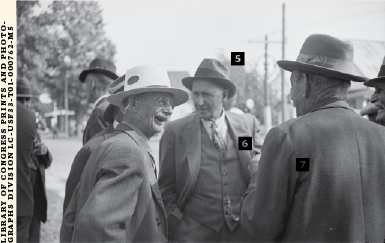
More Online
Photo Detective blog
Men’s clothing in photos
Researching house photos
Fashion trends through the years
Medical clues in family photos
Photo Retouching: How to Bring Old Family Pictures Back to Life on-demand webinar
Digital Photography Essentials Family Tree University Independent Study download
Fashionable Folks: Hairstyles 1840-1900
ADVERTISEMENT

